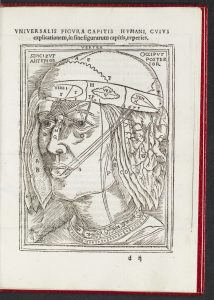Anatomiae, hoc est, Corporis Humani Dissectionis Pars Prior



Johannes Dryander (1500-1560), like his colleague Vesalius, studied at Paris and developed his knowledge of anatomy through human dissection. His 1536 work on the anatomy of the human head is one of the earliest anatomical books, pre-dating Vesalius by seven years. The expanded 1537 edition shown here, contains 17 pages of woodcuts, with a series of eight presenting the stages of dissection of the head and brain. Dryander’s artists (possibly Swiss wood engraver Georg Thomas and/or the German artist Hans Brosamer) peel back the flesh to evoke its three dimensionality (e2r). A fourth dimension adds to the pedagogical purpose, however, in the symbolism of memento mori, which traditionally employed the human skull to remind the viewer of death. For example, in some of the images the artist adds such symbols as the sundial, the hourglass, and even the Latin phrase “inevitabile fatum” (g1r), urging the reader to reflect on the inescapability of death.
